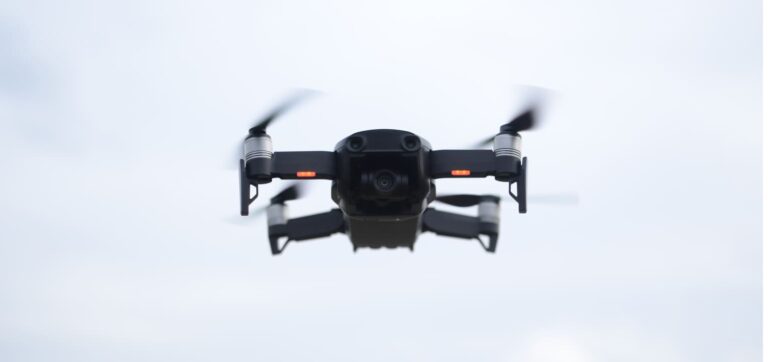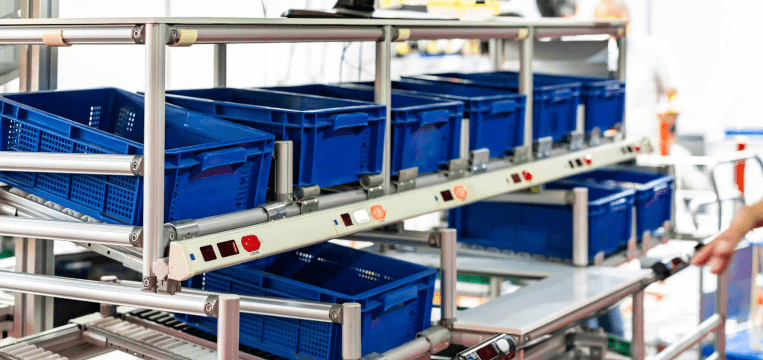Periodical, full inventory counts – whether annual, semi-annual, or quarterly – present warehouses and distribution centers with a serious challenge. To maintain accurate inventory tracking with minimal disturbance, many companies resort to cyclical counting. Drone barcode scanners, equipped with state-of-the-art computer vision, are becoming a popular solution for automating and speeding up this task.
That’s because traditional cycle counting is labor-intensive and costly, making it unattractive for many businesses across various industries, including retail, manufacturing, healthcare, pharmaceuticals, and more.
Warehousing practices have long relied on manual barcode scanning, conducted by workers navigating shelves and pallets. This is an effective method, but it’s also time-consuming and far from infallible. Human error, inevitable in manual tasks, leads to costly discrepancies.
In this article, we’ll examine the benefits and challenges of using autonomous drone barcode scanners in warehouses. We’ll also provide some insights into what to consider for a successful implementation, based on our collaboration with our customers.
What are warehouse drones?
Drones, or unmanned aerial vehicles (UAV), are aerial robotics platforms. Today’s small, agile drones have high-resolution cameras and are perfect for flying around and taking pictures in warehouses. As a result, they are gaining popularity in smart warehouses as efficient tools for inventory management.
Their primary purpose is to streamline the inventory management process: Warehouse drones quickly scan barcodes on items, shelves, or entire storage areas with great precision and send the data directly to the inventory system.
Different levels of drone autonomy
Recent advancements have enabled drones to fly independently through aisles with little to no manual control, as opposed to earlier models. There are even drone types that operate autonomously or through swarm intelligence.
There are now roughly three levels of autonomy, ranging from manual to fully autonomous:
- Manual drone control: A pilot still controls all flight operations manually.
- Partial drone control: Many drones offer partial autonomy, such as automated takeoff or waypoint following, but still require human intervention for the more complex parts of their operations.
- Autonomous drones: These drones operate completely independently, without human control. They can navigate, perform tasks, and make decisions based on GPS, sensors, and AI algorithms.
How does a drone with barcode scanning capabilities work?
Inventory management drones combine specialized hardware and software to deliver fast and accurate barcode scanning.
The hardware demands aren’t trivial: The drone platform needs powerful processing, sensors, and cameras. The camera has to deliver high-resolution pictures, enabling the drone to scan even tiny or distant barcodes. Sensors are crucial for precision navigation and obstacle avoidance. The onboard computer, meanwhile, has to run both flight control and advanced barcode scanner software.
Barcode Scanner SDKs are all-in-one solutions that speed up barcode scanner app deployment. For drone scanning applications, the software should be easy to integrate into existing warehouse management systems (WMS) or enterprise resource planning (ERP) platforms. Simple-to-integrate APIs enable data exchange and communication between the software and the WMS or ERP, which delivers real-time inventory updates.
Though the hardware and software requirements are demanding, the basic operations are quite straightforward: Drones follow predefined routes within the warehouse and scan barcodes as they go. When they detect a barcode, they take a picture with their camera and send the information to the central inventory barcode system. The software then processes the data and updates the database.
This real-time information flow enables timely decision-making, helping businesses stay on top of their inventory needs.
Main applications of warehouse drones
Drones with advanced scanning technology can be used for various applications. Here are some areas where drones are making a significant impact:
- Inventory audits: A key application of drones with barcode scanning capabilities. Traditional manual audits are time-consuming, error-prone, and potentially dangerous. They have to happen outside usual operating times, so that inventory levels can be audited accurately. Employees often need ladders or forklifts to reach high shelves. With warehouse drones, companies can conduct regular, automated audits, reducing the risk of stockouts or overstocking.
- Stock monitoring: Drones help warehouse managers monitor stock levels in real time with minimal manpower. This data is invaluable for optimizing reorder points, reducing carrying costs, and improving order fulfillment efficiency. Warehouse workers, meanwhile, remain available for operational tasks.
- Quality control: Drones can be programmed to identify missing items and incorrect placement of items.
Benefits of drone barcode scanners
The overall benefits of using drone barcode scanners in warehouse operations are enhanced data collection, efficiency, and accuracy. In particular, businesses benefit from:
- Faster throughput: Drones can scan barcodes significantly faster than human operators. This saves time by reducing the labor needed for inventory checks.
- Improved accuracy: Warehouse drones eliminate human error in barcode scanning, ensuring the accuracy of inventory records. This prevents costly inventory discrepancies.
- Enhanced safety: Drones can reach warehouse areas that are dangerous for human workers, such as high shelves or narrow aisles. This enhances warehouse safety and minimizes workplace accidents.
- Cost-efficiency: Drones can save money in the long run. They require an initial investment but reduce labor costs and prevent losses from errors.
- Real-time data insights: Drones can transmit data to the Warehouse Management System in real-time, providing decision-makers with insight into inventory discrepancies, stock movement, cycle count, and audit data.
- Scalability: Drone barcode scanning solutions are adaptable to varying warehouse sizes and complexities. Whether you operate a small-scale distribution center or a vast, multi-facility logistics hub, drone solutions can be tailored to meet your specific needs.
Challenges and considerations
The implementation of drone barcode scanning does pose some challenges:
- Maintenance: Drone scanner hardware and software require regular maintenance and updates to ensure optimal performance and prevent operational disruption.
- Personnel Training: Warehouse staff must be trained in drone operation, including navigation, data extraction, and basic troubleshooting. To encourage usage, drones need to be easily operable.
- Regulatory Compliance: The regulatory landscape surrounding drone usage can be difficult to navigate. To avoid legal complications, you must comply with local, national, and international regulations. For instance, the U.S. Occupational Safety and Health Administration (OSHA) mandates that drone operators in the workplace must receive appropriate training and certification.
- Integration: Integrating drones with barcode scanning capabilities into existing warehouse systems can be a complex process. This makes good planning, support, and execution paramount. Appropriate APIs are needed for a robust integration, ensuring seamless data transfer and minimizing disruptions to operations.
- Cybersecurity concerns: Through unencrypted or poorly secured wireless communication, attackers can intercept sensitive data. All data transmission should be end-to-end encrypted, and software needs to be regularly updated.
- Cost/benefit balance: Though warehouse drones can save costs in the long run, initial costs can be high. For SME, equipping employees with mobile barcode scanners may provide better value. Mobile barcode scanner software often comes with features to speed up workflows, such as batch scanning and multi-scanning, and runs on common smartphones and tablets.
However, in many scenarios, the benefits outweigh the challenges – as long as solutions are carefully considered before implementing a drone warehouse inventory system.
The future of warehousing
Drone barcode scanners are slowly but surely changing the way warehouses operate.
Their ability to deliver speed, precision, and safety can positively impact the company’s bottom line.
Warehouse operators committed to staying on top of the industry and embracing innovation should consider optimized barcode scanners as an investment in their future success. The adoption of drone barcode scanners is poised to be a pivotal chapter in the ongoing story of warehouse innovation.
That’s why we at Scanbot SDK teamed up with Cypher Robotics. Powered by our Linux Barcode Scanner SDK, their drone systems automate inventory cycle counting for warehouse clients.
You can run our Linux Barcode Scanner SDK as a headless solution for fast and reliable barcode scanning in server environments and for embedded systems. It focuses on processing image data and returning barcode data as a list. The SDK is suited for a variety of deployment scenarios, including private clouds and physical hardware such as drones, robots, and edge devices.
The core API is written in pure C, which enables easy integration into other programming environments through simple wrappers. For a quick start, the SDK also includes wrappers for C++ and Python.
Take a look at our tutorials for the Python and C++ implementations to learn more. You can also contact our solution experts so we can discuss your individual use case in more detail.
What are the key features to look for when choosing a drone barcode scanner for warehouse use?
A warehouse drone barcode scanner should come with advanced barcode scanning capabilities. Scanning multiple barcodes at once or in succession – with features such as multi and batch scanning – maximizes operational efficiency.


